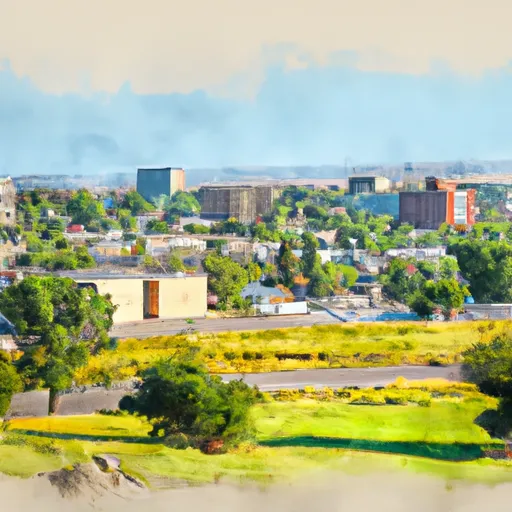-
 Snoflo Premium
Snoflo Premium
Get unlimited access to all our content
With no Ad interruptions! - Start Your Free Trial Login with existing account
Ryan-Park
Eden Index
Climate
6.7
•
Recreation
1.0
•
Community
•
Safeguard
3.0/10

Ryan-Park, Wyoming is a small, picturesque town nestled in the scenic Medicine Bow National Forest. The town experiences a continental climate, characterized by cold winters and mild summers. Average winter temperatures range from 5°F to 25°F, while summer temperatures typically vary between 50°F and 75°F.
Hydrologically, Ryan-Park is blessed with numerous pristine lakes, rivers, and streams, making it an ideal destination for fishing enthusiasts. Renowned for its trout population, the area offers excellent angling opportunities throughout the year. The serene waters of the nearby Platte River are perfect for kayaking and canoeing.
Outdoor recreation opportunities abound in Ryan-Park. The Medicine Bow National Forest offers miles of scenic hiking and biking trails, inviting visitors to explore the breathtaking landscapes. Hunting is also popular in the area, with an abundance of elk, deer, and other game species. During winter, the forest transforms into a winter wonderland, attracting snowmobilers and cross-country skiers.
In conclusion, Ryan-Park, Wyoming offers a unique blend of diverse outdoor activities, from fishing in crystal-clear waters to exploring the beautiful forests and engaging in thrilling winter sports. Nature enthusiasts and adventure seekers will find plenty to enjoy in this charming town.
What is the Eden Index?
The Snoflo Eden Index serves as a comprehensive rating system for regions, evaluating their desirability through a holistic assessment of climate health, outdoor recreation opportunities, and natural disaster risk, acknowledging the profound impact of these factors on livability and well-being.
Climate Health Indicator (CHI): 6.7
Ryan-Park receives approximately
263mm of rain per year,
with humidity levels near 61%
and air temperatures averaging around
7°C.
Ryan-Park has a plant hardyness factor of
4, meaning
plants and agriculture in this region thrive during a short period during spring and early summer. Most
plants will die off during the colder winter months.
By considering the ideal temperature range, reliable water supplies, clean air, and stable seasonal rain or snowpacks, the Climate Health Indicator (CHI) underscores the significance of a healthy climate as the foundation for quality living.
A healthy climate is paramount for ensuring a high quality of life and livability in a region, fostering both physical well-being and environmental harmony. This can be characterized by ideal temperatures, reliable access to water supplies, clean air, and consistent seasonal rain or snowpacks.
Weather Forecast
Streamflow Conditions
North Platte
Area Rivers
North Platte
Snowpack Depths
North Platte
Reservoir Storage Capacity
North Platte
Groundwater Levels
Recreational Opportunity Index (ROI): 1.0
The Recreational Opportunity Index (ROI) recognizes the value of outdoor recreational options, such as parks, hiking trails, camping sites, and fishing spots, while acknowledging that climate plays a pivotal role in ensuring the comfort and consistency of these experiences.
Access to outdoor recreational opportunities, encompassing activities such as parks, hiking, camping, and fishing, is crucial for overall well-being, and the climate plays a pivotal role in enabling and enhancing these experiences, ensuring that individuals can engage in nature-based activities comfortably and consistently.
Camping Areas
| Campground | Campsites | Reservations | Toilets | Showers | Elevation |
|---|---|---|---|---|---|
| Encampment City Park | None | 7,277 ft | |||
| Hinman Park | 13 | 7,678 ft | |||
| Bottle Creek | 16 | 8,722 ft | |||
| Encampment River | 8 | 7,307 ft | |||
| Hog Park | 17 | 8,468 ft | |||
| Seedhouse | 24 | 8,071 ft | |||
| Pearl Lake State Park | 38 | 8,138 ft | |||
| Steamboat Lake State Park | 178 | 8,077 ft | |||
| Big Creek Lakes | 54 | 9,007 ft | |||
| Bennett Peak | 11 | 7,137 ft |
Nearby Ski Areas
Catastrophe Safeguard Index (CSI):
The Catastrophe Safeguard Index (CSI) recognizes that natural disaster risk, encompassing floods, fires, hurricanes, and tornadoes, can drastically affect safety and the overall appeal of an area.
The level of natural disaster risk in a region significantly affects safety and the overall livability, with climate change amplifying these risks by potentially increasing the frequency and intensity of events like floods, fires, hurricanes, and tornadoes, thereby posing substantial challenges to community resilience and well-being.
Community Resilience Indicator (CRI):
The Community Resilience Indicator (CRI) recognizes that education, healthcare, and socioeconomics are crucial to the well-being of a region. The CRI acknowledges the profound impact of these elements on residents' overall quality of life. By evaluating educational resources, healthcare accessibility, and economic inclusivity, the index captures the essential aspects that contribute to a thriving community, fostering resident satisfaction, equity, and social cohesion.

